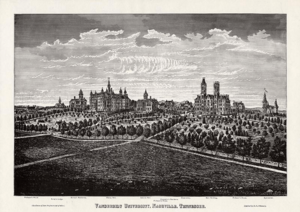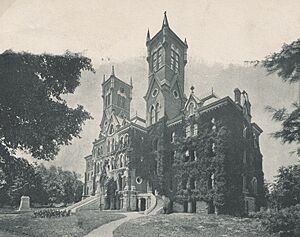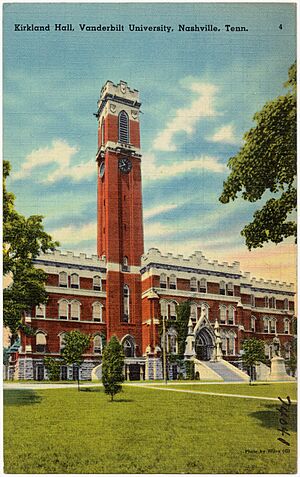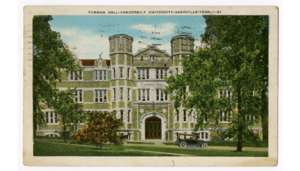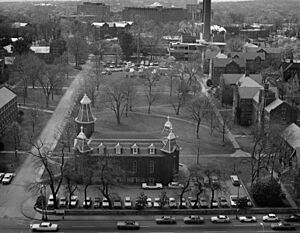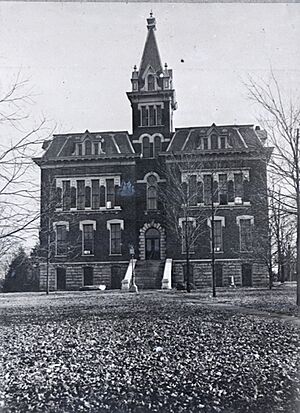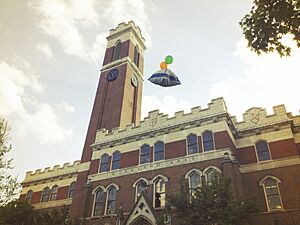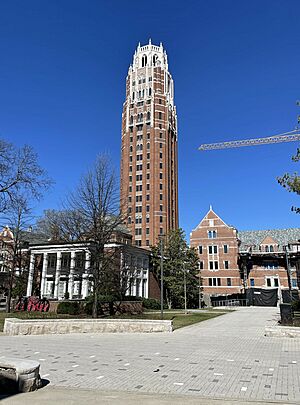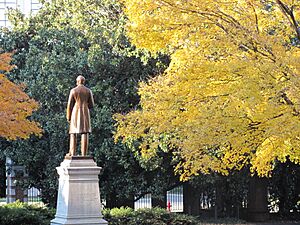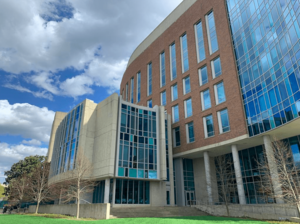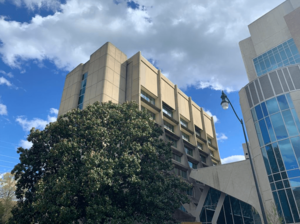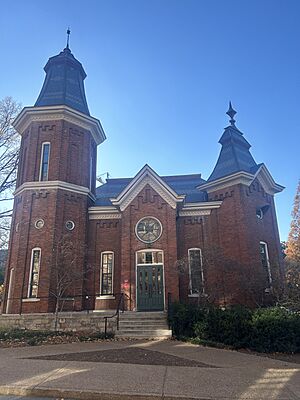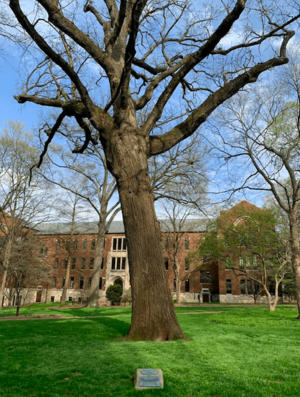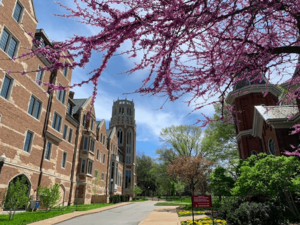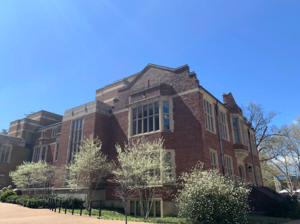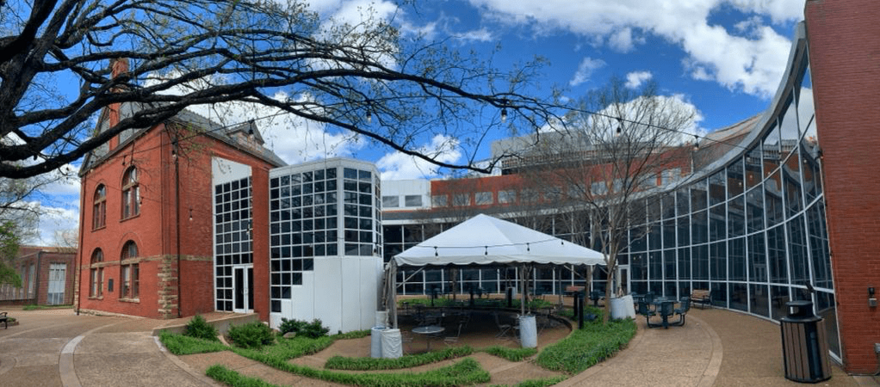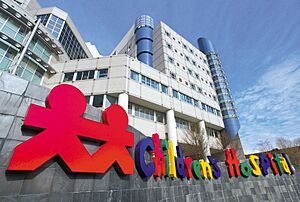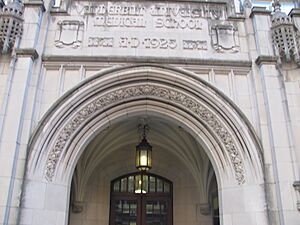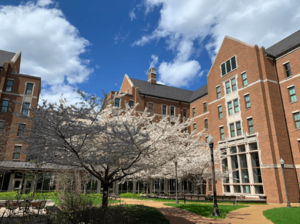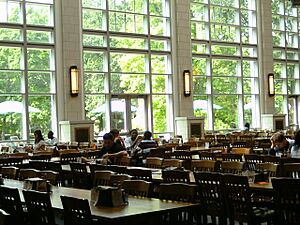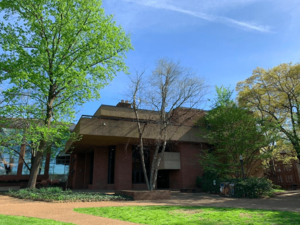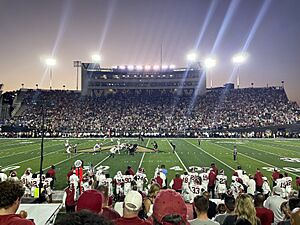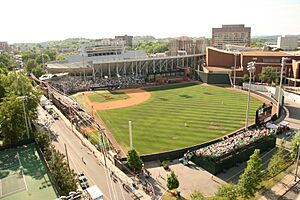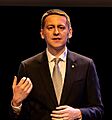Vanderbilt University facts for kids
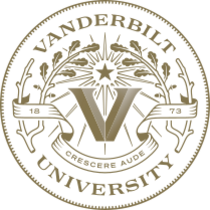 |
|
|
Former name
|
Central University (1873–1877) |
|---|---|
| Motto | Crescere aude (Latin) |
|
Motto in English
|
"Dare to grow" |
| Type | Private research university |
| Established | 1873 |
| Accreditation | SACS |
|
Academic affiliations
|
|
| Endowment | $10.2 billion (2024) |
| Chancellor | Daniel Diermeier |
| Provost | C. Cybele Raver |
|
Academic staff
|
1,847 (2023) |
|
Total staff
|
6,654 (2023) |
| Students | 13,575 (2024) |
| Undergraduates | 7,221 (2024) |
| Postgraduates | 6,354 (2024) |
| Location |
,
,
United States
36°8′51″N 86°48′9″W / 36.14750°N 86.80250°W |
| Campus | Large city, 330 acres (1.3 km2) |
| Other campuses | Brentwood |
| Newspaper | The Vanderbilt Hustler |
| Colors | Black and Old Gold |
| Nickname | Commodores |
|
Sporting affiliations
|
|
| Mascot | Mr. Commodore (Mr. C) |
| Website | vanderbilt.edu |
 |
|
Vanderbilt University (often called Vandy or VU) is a private research university located in Nashville, Tennessee, United States. It was started in 1873. The university is named after Cornelius Vanderbilt, a very rich businessman. He gave the school its first $1 million to help heal the country after the American Civil War. Vanderbilt is a founding member of the Southeastern Conference for sports. It has been the only private school in that conference since 1966.
Vanderbilt has ten different schools and nearly 13,800 students. These students come from all over the US and 70 other countries. Vanderbilt is known for its very high research activity. Many research centers are connected to the university, like the Robert Penn Warren Center for the Humanities. The Vanderbilt University Medical Center used to be part of the university but became a separate organization in 2016. Most of the university's buildings are on its 330-acre campus in Nashville, about 1.5 miles from downtown.
Many famous people have attended or worked at Vanderbilt. This includes 9 Nobel Prize winners, 2 US Vice Presidents, and 2 US Supreme Court justices. Other notable alumni include 3 Pulitzer Prize winners and 5 Olympic medalists. Vanderbilt has over 145,000 alumni around the world.
Contents
History of Vanderbilt University
How Vanderbilt Started
Before the American Civil War (1861–1865), the Methodist Episcopal Church South wanted to create a university. They wanted a place to train ministers. In 1872, church leaders decided to open "The Central University" in Nashville. But they didn't have enough money because the South was still recovering from the war.
The next year, a bishop named Holland Nimmons McTyeire met Cornelius Vanderbilt in New York City. Vanderbilt was the richest man in the US. He had planned to start a university in New York. But McTyeire convinced him to give $500,000 to Central University. Vanderbilt hoped his gift would help unite the country after the war.
Vanderbilt later increased his gift to $1 million. Even though he didn't ask for it, the trustees renamed the school "Vanderbilt University" in 1873 to honor him. They bought land from Henry S. Foote, a former Confederate Congressman.
The first building, Main Building (later called Kirkland Hall), started being built in 1874. In the fall of 1875, about 200 students joined Vanderbilt. The university officially opened in October. Bishop McTyeire was made chairman of the Board of Trust for life. He chose Landon Garland as the first chancellor. Garland helped shape the school and hired its first teachers.
In 1880, the Old Gym was finished. It was the university's first gymnasium. By 1883, the school allowed student groups called fraternities on campus.
In 1905, the Main Building (Kirkland Hall) burned down. It originally had two towers. It was rebuilt with one tower in a different style after the university received donations.
Early Leaders and History
Some of Vanderbilt's early leaders had connections to slavery and the Confederacy before the Civil War. For example, Bishop McTyeire was born into a family that owned slaves. Landon Garland, the first chancellor, also owned slaves before the war. One of the founding trustees, Hezekiah William Foote, was a Confederate veteran and owned plantations. The Elliston family, who owned slaves, donated some of their land for the campus to grow.
Vanderbilt and the Methodist Church
For its first 40 years, Vanderbilt University was controlled by the Methodist Episcopal Church, South. But there were disagreements between the university and the church. They argued about how the university's leaders would be chosen and if non-Methodists could teach there.
The conflicts grew after James H. Kirkland became chancellor in 1893. The Methodist Church tried to take more control. In 1910, the university's board refused to let three Methodist bishops join. The church took the issue to court.
On March 21, 1914, the Tennessee Supreme Court decided that Cornelius Vanderbilt, not the Methodist Church, was the university's founder. This meant the university's board could choose its own members. The Methodist Church then voted to separate from Vanderbilt. They decided to start a new university, Southern Methodist University, and expand Emory University.
Colonel Edmund William Cole, a Confederate veteran and railroad executive, was the treasurer of the Board of Trust. His son, Whitefoord Russell Cole, later became chairman of the board. He supported Chancellor Kirkland's decision to separate from the Methodist Church.
From the 1920s to World War II
In the 1920s and 1930s, Vanderbilt was home to important groups of writers and thinkers. These included the Fugitives and the Southern Agrarians. In 1925, Frank C. Rand donated money, and Rand Hall was named after him.
In 1928, three more buildings were finished: Garland Hall, Buttrick Hall, and Calhoun Hall.
In 1933, the United Daughters of the Confederacy donated money to build Confederate Memorial Hall. It was finished in 1935.
During the 1930s, scientists at the School of Medicine found ways to grow viruses in chicken eggs. This helped create vaccines for diseases like chicken pox and yellow fever. Their work saved many lives during World War II. Vanderbilt was one of many colleges that helped train students for the Navy during the war.
In 1940, Max Delbrück, a German biophysicist, joined Vanderbilt. He and Salvador Luria later showed that Darwin's theory of natural selection also applies to bacteria. They won the Nobel Prize in Physiology or Medicine in 1969 for this discovery.
After the war, from 1945 to 1949, researchers at Vanderbilt gave radioactive iron to pregnant women without their full consent. This was part of a study on iron. In 1998, the university settled a lawsuit with the women and their children for $10.3 million.
The 1950s and 1960s
In the early 1950s, some of the first women graduated as engineers from Vanderbilt. In 1953, the first African American student was admitted to the School of Divinity. In 1960, Chancellor Branscomb expelled Divinity student James Lawson. Lawson was a civil rights leader who organized sit-ins against segregation. Many teachers resigned to protest this decision. Lawson was later rehired as a professor and recognized for his achievements.
In 1962, the university decided to admit African Americans to all its schools. The first black undergraduates started in 1964. In 1966, Vanderbilt gained national attention when it recruited Perry Wallace. He was the first African American to play varsity basketball in the Southeastern Conference (SEC). Wallace faced many challenges from people who supported segregation. In 2004, his jersey was retired to honor him.
Since 1964, Vanderbilt has held its IMPACT Symposium. This event brings famous speakers to discuss important and sometimes controversial topics. Past speakers include Martin Luther King Jr., Robert F. Kennedy, and several US Presidents.
From the 1970s to Today
In 1979, Vanderbilt took over Peabody College, which was then called the "George Peabody College for Teachers." Peabody College has a history going back to 1785.
In 1989, Vanderbilt started offering Posse Foundation scholarships. These help promising young leaders from cities attend the university.
In 2001, the university decided to change its undergraduate experience. They started creating an academic residential college system. This means students live in special dorms that are also learning communities.
In 2002, the university wanted to rename Confederate Memorial Hall to Memorial Hall. This caused a lot of discussion and a lawsuit. In 2016, the university finally removed the word "Confederate" from the building's name after receiving donations to cover the costs.
In 2009, Vanderbilt started a "no-loan" policy. This means that students who need financial help get grants instead of loans. In 2015, they started "Opportunity Vanderbilt," which means they meet 100% of a student's financial need with grants.
In 2012, Vanderbilt built Elliston Hall. In 2015, Vanderbilt opened a new innovation center called The Wond'ry. It's a place for students to work together on new ideas and projects.
In April 2024, Vanderbilt students joined protests supporting Palestine. They asked the university to stop doing business with companies involved in Israel. The protests grew when the university stopped a student vote on a related resolution. Some students were arrested and expelled. Many faculty members disagreed with the university's actions.
Academics at Vanderbilt
| Admissions statistics | |
|---|---|
|
2022 entering
class |
|
| Admit rate | 6.1% |
| Yield rate | 52.3% |
| Test scores middle 50% | |
| SAT EBRW | 730-770 |
| SAT Math | 760-800 |
| ACT Composite | 34-35 |
As of 2021, Vanderbilt had about 7,111 undergraduate students and 6,685 graduate students. Students come from all 50 US states and over 100 countries. About 68% of undergraduate students are from outside the South. About 10% are from outside the United States.
Vanderbilt offers over 70 different majors for undergraduate students. These are spread across four schools:
- College of Arts and Science
- School of Engineering
- Peabody College of Education and Human Development
- Blair School of Music
The university also has six schools for graduate and professional students. These include Law, Medicine, and Nursing. In 2021, Vanderbilt had a student-to-teacher ratio of 8:1.
Getting into Vanderbilt's undergraduate programs is very competitive. In 2022, only 6.1% of applicants were accepted. Vanderbilt is one of the most selective universities in the United States. Many students who get in are top students from their high schools.
Research and Discoveries
Vanderbilt spends a lot of money on research. In 2021, it spent $1 billion on research and development. This made it one of the top research universities in the US. Its Institute for Space and Defense Electronics is the largest academic center in the world for studying how radiation affects electronics.
Vanderbilt has some unique research areas. It has institutes that study coffee and bridge. The modern game of bridge was even developed by Harold Stirling Vanderbilt, a former leader of the university. In 2004, Vanderbilt's research in chemical biology accidentally led to a possible way to create a blue rose.
In 2010, Vanderbilt started testing a powered exoskeleton. This is a special suit that helps people who are paralyzed or have trouble walking. It helps them walk on their own.
Vanderbilt was also involved in discovering tennessine (Ts), element 117 on the periodic table. It was named after the state of Tennessee in 2016.
University Rankings
|
|
|
||||||||||||||||||||||||||||||||||||||||||||||||||||||||||||||||||||||||||||||||||||||||||||||||||||||||||||||||
Vanderbilt is consistently ranked among the top universities in the United States. U.S. News & World Report ranked Vanderbilt 18th among 'Best National Universities' in 2025. Niche ranked Vanderbilt the 14th best college in America in 2024.
Many of Vanderbilt's graduate programs are also highly ranked. For example, the Peabody College of Education was ranked the 2nd best national school of education in 2024. The School of Medicine was ranked 5th for research.
Vanderbilt also does well in non-academic rankings. In 2017, The Princeton Review ranked it first for happiest students and fifth for most beautiful campus. Travel + Leisure listed Vanderbilt as having one of the most beautiful campuses in the country in 2016.
Vanderbilt Campus
The Vanderbilt campus is about 1.5 miles southwest of downtown Nashville. It covers 330 acres. The oldest part of the campus is known for its many trees and green spaces. In 1988, the campus was named a national arboretum. It has about 190 different kinds of trees and shrubs. One tree, the Bicentennial Oak, was certified to have lived during the American Revolution. It was the oldest living thing on campus until it fell in 2022 due to age.
Main Campus Area
The original part of the campus is in the northeast corner. This area has most of the arts and humanities buildings. It also has the law school, business school, and divinity school. The Heard Central Library and Sarratt Student Center are also here.
South of the original campus are the Stevenson Center for Science and Mathematics and the School of Engineering. These buildings house science, math, and engineering departments. The Vanderbilt University Medical Center is in the southeastern part of campus. It includes hospitals, clinics, and research facilities.
West of the main campus are the student dorms and Greek Row. Most students live on campus in 20 different residence halls and apartments.
The buildings on campus have many different styles. Kirkland Hall, built in 1873, is one of the most recognizable buildings. It was rebuilt with one tower after a fire in 1905. Campus planners work to keep the landscape and old buildings looking good.
Memorial Gymnasium, Vanderbilt Stadium, and other sports facilities are in the far west of campus.
Peabody Campus Area
Across 21st Avenue from the Medical Center is "Commons." This is home to the Peabody College of Education and Human Development. The design of the Commons campus was inspired by Thomas Jefferson's design for the University of Virginia. The central lawn and buildings here were named a historic district in 1965. The Commons campus also has the Martha Rivers Ingram Commons, where all first-year students live.
New York Campus Area
In September 2024, Vanderbilt University signed an agreement to use part of the General Theological Seminary campus in Chelsea, Manhattan, New York City. The seminary will still use some space there. The exact plans for Vanderbilt's use of this location have not yet been announced.
How Vanderbilt is Organized
| College/school |
|
| Arts and Science |
|
| Law |
|
| Medicine |
|
| Divinity |
|
| Education and Human Development |
|
| Graduate School |
|
| Engineering |
|
| Nursing |
|
| Music |
|
| Management |
|
Vanderbilt University is run by a group called the Board of Trust. This board has 45 members and the chancellor, who is the university's main leader. Each trustee serves for five years. Bruce R. Evans is the current chairman of the board.
Daniel Diermeier has been the chancellor of Vanderbilt University since July 1, 2020.
Past Chancellors
Since 1875, only nine people have been chancellor.
- Landon Garland (1875–1893) was the first chancellor. He helped organize the university.
- James Kirkland (1893–1937) served the longest. He helped separate the university from the Methodist Church.
- Oliver Carmichael (1937–1946) helped develop the graduate school.
- Harvie Branscomb (1946–1963) opened admissions to all races.
- Alexander Heard (1963–1982) oversaw the founding of the business school and the merger with Peabody College.
- Joe B. Wyatt (1982–2000) helped increase the university's funding and student diversity.
- Nicholas S. Zeppos (2008–2019) was named chancellor after Gordon Gee left.
- Daniel Diermeier became chancellor on July 1, 2020.
Vanderbilt University Medical Center
Until April 2016, the Vanderbilt University Medical Center (VUMC) was part of the university. Now, it is a separate organization. However, it still works closely with the university. Many medical staff also teach at the Vanderbilt University School of Medicine and Vanderbilt University School of Nursing.
VUMC includes several hospitals and clinics, like Vanderbilt University Hospital and the Monroe Carell Jr. Children's Hospital at Vanderbilt. Before it separated, Vanderbilt was the largest private employer in Middle Tennessee.
Undergraduate Schools
The College of Arts and Science is the oldest and largest of Vanderbilt's colleges. It offers Bachelor of Arts degrees to undergraduates. It also works with the Graduate School to offer Master's and PhD degrees. The college has many research centers, like the Center for Latin American Studies.
The most popular majors are economics, medicine, health, and society, political science, neuroscience, and psychology. The college also helps students prepare for careers in medicine, law, and nursing.
Student Life at Vanderbilt
| Race and ethnicity | Total | ||
|---|---|---|---|
| White | 41% |
|
|
| Asian | 17% |
|
|
| Black | 11% |
|
|
| Other | 11% |
|
|
| Hispanic | 11% |
|
|
| Foreign national | 9% |
|
|
| Economic diversity | |||
| Low-income | 16% |
|
|
| Affluent | 84% |
|
|
Residential College System
Vanderbilt has been changing its dorms into an academic residential college system. The goal is to create communities where students can live, learn, and grow together. The first part of this system, The Martha Rivers Ingram Commons, opened in 2008. All first-year students live in its 10 houses, each with a faculty head.
After their first year, students move into a Residential College for the rest of their time at Vanderbilt. Warren College and Moore College opened in 2014. E. Bronson Ingram College opened in 2018. Zeppos College, Rothschild College, and Carmichael College opened between 2020 and 2024.
Many of the new buildings have received special environmental certifications. This shows Vanderbilt's commitment to being eco-friendly. Most undergraduate students are required to live in dorms on campus.
Student Groups and Activities
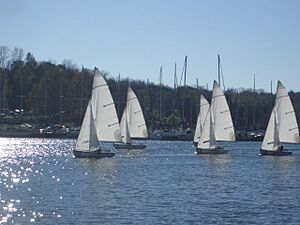
Vanderbilt has over 430 student organizations. These include academic clubs, sports clubs, and performing arts groups. The oldest sports club is the Vanderbilt Sailing Club.
The Vanderbilt Hustler is the university's student newspaper. It started in 1888 and is the oldest continuously published newspaper in Nashville. Other student publications include the Vanderbilt Political Review. The campus radio station, WRVU, plays a variety of music.
Vanderbilt has a large performing arts community. There are dance groups, theater groups, and singing groups. The male a cappella group, The Melodores, even won a national competition in 2014.
The student body is led by the Vanderbilt Student Government. This group helps manage funds for student organizations.
Greek Life
Vanderbilt has a Greek system with 14 fraternities and 9 sororities. In the 2021–22 school year, about 23% of all undergraduate students were part of a Greek organization.
Student Discussions and Changes
In 1980, some students protested about historical symbols on campus. The university allowed one group to parade in certain costumes, which led to further student discussions.
In 2010, there was a disagreement within a Christian fraternity about its membership rules. This led to discussions about student group policies and inclusion.
In 2011, some Christian student groups faced probation. This was because they did not follow the university's policy that requires student groups to accept all students. This led to a debate about non-discrimination policies.
In March 2015, offensive symbols were found spray-painted at a Jewish fraternity house. University officials called it a "hate crime." The news made headlines and was condemned by the university.
In July 2020, a video showed students using offensive language. This led to hundreds of students leaving their fraternities and sororities. It also sparked a national "Abolish Greek Life" movement at other universities.
In 2021 and 2023, construction workers died on campus. The university stated the deaths were due to natural causes. Students organized the "Dores Worker Solidarity Network" to advocate for better construction practices.
In 2024, university leaders stopped the student government from voting on a resolution about global issues. Students protested with sit-ins. Some students were expelled or suspended, and a reporter was arrested.
Vanderbilt Athletics
Vanderbilt is a founding member of the Southeastern Conference (SEC). It has been the only private school in the conference for 50 years. The university has six men's and ten women's sports teams. They have won six NCAA championships. Vanderbilt is the smallest school in the SEC, with about 7,000 undergraduate students.
Vanderbilt also has teams in sports not sponsored by the SEC. The women's lacrosse team plays in the American Athletic Conference. The women's bowling team is part of Conference USA. Vanderbilt is the only SEC school without softball and volleyball teams, though volleyball will return in the 2025–26 school year.
Both basketball teams play in Memorial Gym, built in 1952. Vanderbilt's home court advantage is known as "Memorial Magic."
Athletic Success
Vanderbilt has had a lot of success in sports. The 2006–07 school year was one of the best. At one point, seven of Vanderbilt's 16 teams were ranked in the Top 25 nationally. The women's bowling team won the NCAA championship, which was the university's first team championship.
The baseball team has also been very successful. They won the College World Series in both 2014 and 2019. The 2014 win was the school's first national championship in a men's sport.
Vanderbilt Mascot
Vanderbilt's sports teams are called the Commodores. This nickname honors Cornelius Vanderbilt, who made his money in shipping. A "commodore" was a naval officer rank in the 19th century. Vanderbilt's mascot, "Mr. C," looks like a naval officer from that time.
Vanderbilt fans often cheer "Anchor down!" They also make a "VU" hand sign by extending their thumb, index, and middle fingers.
| Men's | Women's |
|---|---|
| Baseball | Basketball |
| Basketball | Bowling |
| Cross country | Cross country |
| Football | Golf |
| Golf | Lacrosse |
| Tennis | Soccer |
| Swimming | |
| Spirit - Cheer and Dance | |
| Tennis | |
| Track and field |
Notable People from Vanderbilt
Alumni (Former Students)
- Notable Vanderbilt alumni include:
-
Nobel Peace Prize winner Muhammad Yunus (PhD, 1971)
-
32nd Vice President of the United States John Nance Garner (Law, 1886)
-
45th Vice President of the United States and Nobel Peace Prize winner Al Gore (Div, 1971–72)
-
Chemist and Nobel Prize winner John Jumper (BS, 2007)
-
American author James Patterson (MA, 1970)
-
Pulitzer Prize-winning author Robert Penn Warren (BA, 1925)
-
63rd Governor of Kentucky Andy Beshear (BA, 2000)
-
48th Governor of Texas Greg Abbott (JD, 1984)
-
Chinese businessman Charlie Soong (Div, 1885)
-
Founder of Bain & Company Bill Bain (BA, 1959)
Many Vanderbilt alumni have become important leaders. This includes presidents and prime ministers of other countries. Two US Vice Presidents, John Nance Garner and Al Gore, also attended Vanderbilt. Other notable political figures include governors and members of the US Congress.
In business, alumni include CEOs of major companies like Nasdaq, Inc. and American Airlines Group. Founders of important consulting firms like Bain and Company also studied at Vanderbilt.
In science and academics, alumni include a Nobel Prize in Chemistry winner, NASA astronauts, and famous philosophers. Doctors from Vanderbilt have made important medical discoveries, like the first successful heart transplant in the US.
Vanderbilt graduates have also made big contributions to literature. Famous poets and writers, including Pulitzer Prize winners, are alumni. Journalists and people in popular culture, like actors and musicians, have also attended Vanderbilt.
Many professional athletes have come from Vanderbilt. This includes players in the NFL, MLB, and NBA. Olympic medalists have also studied here.
Faculty (Teachers)
- Notable past and present Vanderbilt faculty include:
-
Biophysicist and Nobel Prize winner Max Delbrück
-
Mathematician and Fields medalist Vaughan Jones
-
French mathematician and Fields medalist Alain Connes
-
Pulitzer Prize-winning author Jon Meacham
Vanderbilt has also had many famous faculty members. These include NASA astronauts, Nobel Prize winners, and Fields Medal winners (a top award in mathematics).
See also
 In Spanish: Universidad Vanderbilt para niños
In Spanish: Universidad Vanderbilt para niños
- Latin American Public Opinion Project
- Southern Ivy



